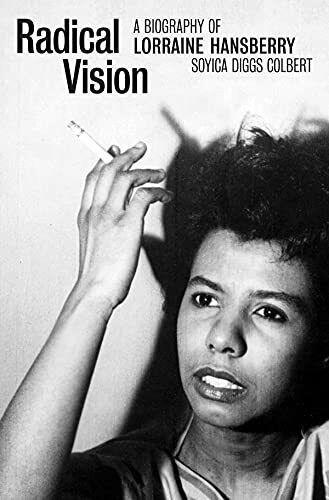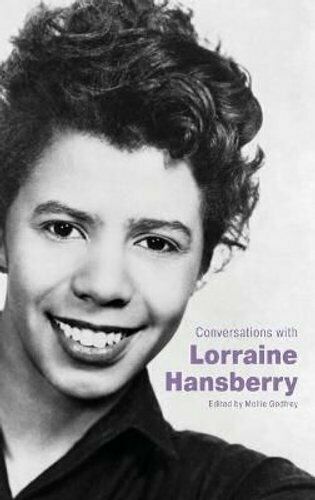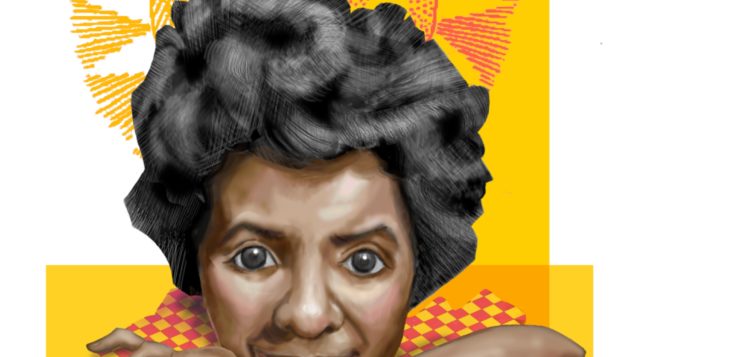 RADICAL VISION
RADICAL VISION
A Biography of Lorraine Hansberry
by Soyica Diggs Colbert
Yale University Press. 288 pages, $30.
 CONVERSATIONS WITH LORRAINE HANSBERRY
CONVERSATIONS WITH LORRAINE HANSBERRY
Edited by Mollie Godfrey
University Press of Mississippi
250 pages, $25.
WHEN Lorraine Hansberry burst onto the national scene with her play A Raisin in the Sun in 1959, one popular image of her can be summed up by journalist Mike Wallace’s introduction to the playwright in an interview. The first African-American woman to have a play produced on Broadway, and the first to win the New York Drama Critics Circle Award, was described as “a girl who had dabbled in writing [who]made a brash announcement to her husband. She was going to sit down and write an honest and accurate drama about Negroes.”
The idea that Hansberry came out of nowhere to become an overnight success with A Raisin in the Sun is one of the misperceptions that’s dispelled by two new books on Hansberry, which show her to be a passionate and dedicated writer, artist, thinker, and activist.
Born in Chicago in 1930, Lorraine Hansberry came from a comfortably middle-class background, albeit still segregated on the city’s South Side. Her father Carl ran a successful real estate business and was a founder of one of the first Black banks in Chicago. When she was eight years old, her family attempted to move into a restricted neighborhood. They were threatened by a white mob, which threw a brick through a window, narrowly missing Lorraine. While the Supreme Court of Illinois upheld the legality of the restrictive covenant and forced the family to leave the house, the U.S. Supreme Court ultimately reversed that decision. Clearly this experience of racism was formative in her early life, becoming the basis for the central conflict in A Raisin in the Sun. Soon afterward, Carl made the decision to move the family to Mexico, but he died there in 1946 before the family could expatriate.
Hansberry attended but dropped out of the University of Wisconsin and, in 1950, moved to New York, eventually becoming associate editor of singer-activist Paul Robeson’s newspaper Freedom, which put her into contact with many literary and left-leaning political leaders, such as Robeson himself and W. E. B. Du Bois. While at Freedom, she reported on African independence movements and Civil Rights events, such as the meeting between the woman-centered protest organization Sojourners for Truth and Justice and a U.S. Justice Department official to present evidence of injustice against African-American women. She also traveled to Uruguay on Paul Robeson’s behalf to serve as a delegate for the 1952 Inter-Continental Peace Congress Conference, which brought her to the attention of the FBI.
During a protest against racial discrimination at NYU, she met Jewish writer Robert Nemiroff, whom she married in 1953. In 1956, the royalties from a hit song her husband co-wrote allowed Hansberry to quit working and devote herself to writing full-time. Setting A Raisin in the Sun in Chicago, Hansberry incorporated elements of herself and her family in her depiction of the working-class Younger family. Their dialogue, in her own words, had to be “to the best of my creative ability, the idiom, typical vocabulary, and rhythms of Chicago’s South Side where I grew up. … [I]t is speech which has surrounded my life and senses since birth.”
 Not a straightforward biography, Radical Vision delves into the influences on the playwright’s thought and art. It explores in detail many of Hansberry’s unproduced and unfinished plays, stories, speeches, and other writings. This deep dive into, and close reading of, Hansberry’s archive shows how her work became “more explicitly radical after Raisin” in response to the growing Civil Rights movement of the early 1960s. It also reveals a number of interesting personal details, such as her brief relationship with photographer Molly Malone Cook, who later became the partner of poet Mary Oliver. Under pseudonyms, Hansberry also sent two short stories to the L.A.-based homophile journal One magazine, as well as letters and short stories to The Ladder, published by the Daughters of Bilitis, describing herself in one letter as a “heterosexually married lesbian.” (She and her husband separated in 1957 and secretly divorced seven years later.) Two of her plays, The Sign in Sidney Brustein’s Window and Les Blancs (which was not produced in her lifetime), feature gay male characters.
Not a straightforward biography, Radical Vision delves into the influences on the playwright’s thought and art. It explores in detail many of Hansberry’s unproduced and unfinished plays, stories, speeches, and other writings. This deep dive into, and close reading of, Hansberry’s archive shows how her work became “more explicitly radical after Raisin” in response to the growing Civil Rights movement of the early 1960s. It also reveals a number of interesting personal details, such as her brief relationship with photographer Molly Malone Cook, who later became the partner of poet Mary Oliver. Under pseudonyms, Hansberry also sent two short stories to the L.A.-based homophile journal One magazine, as well as letters and short stories to The Ladder, published by the Daughters of Bilitis, describing herself in one letter as a “heterosexually married lesbian.” (She and her husband separated in 1957 and secretly divorced seven years later.) Two of her plays, The Sign in Sidney Brustein’s Window and Les Blancs (which was not produced in her lifetime), feature gay male characters.
Conversations with Lorraine Hansberry collects her most substantive public interviews transcribed directly from the original recordings, including some which were not aired or not aired in their totality when originally broadcast. Edited by Mollie Godfrey, associate professor of English at Virginia’s James Madison University, the interviews and panel discussions track her career from the start of her fame in 1958 to six months before her untimely death in 1965. A brief chronology of Hansberry’s life and a conversation between two African-American scholars on her lasting influence round out the book.
None of the conversations reveal many details about Hansberry’s private life—not a surprise, considering the homophobia of her times. However, her remarks on the difficulty of getting work by African-American writers published and getting “serious” plays produced on Broadway sound remarkably contemporary. In 1964, she commented on some white people’s support for the Civil Rights movement: “We have to find some way with these dialogues to show and to encourage the white liberal to stop being a liberal and become an American radical. … The basic fabric of our society, after all, is the thing that must be changed in order to solve the problem.” These words could easily have been spoken by a Black Lives Matter activist today. Of her death at age 34, critic Lisbeth Lipari observed that Hansberry was “one year older than Toni Morrison, four years older than Audre Lorde, two years younger than Maya Angelou, and one year younger than Adrienne Rich—one can only imagine the contribution Hansberry might have made had she lived longer.”
Reginald Harris, a writer and poet based in Brooklyn, is the author ofTen Tongues (2003) andAutogeography (2013).






